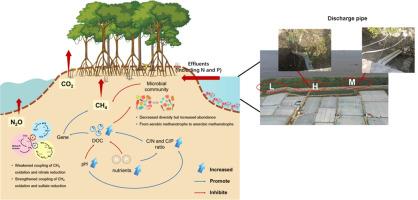大量水产养殖流出物输入的营养富集加剧了红树林沉积物中甲烷产生和氧化之间的不平衡
IF 12.4
1区 环境科学与生态学
Q1 ENGINEERING, ENVIRONMENTAL
引用次数: 0
摘要
频繁的水产养殖活动为红树林生态系统带来大量营养;然而,这种营养物富集对甲烷(CH4)排放和相关微生物群落的影响在很大程度上仍未被探索。在这项研究中,我们使用静态室方法,结合基于16S rrna的宏基因组测序和分类技术,研究了不同水平污水下红树林温室气体(ghg)的排放模式,特别是CH4。结果表明,污水输入降低了沉积物碳(C)库的矿物保护作用,使碳损失增加了一倍以上。特别是高出水投入使CH4排放量增加了243.3%。随机森林分析表明,产甲烷菌的变化是解释CH4排放变化的重要因素。Amplicon数据显示,污水输入后,甲基化产甲烷菌的比例增加,宏基因组分类进一步将这种变化归因于甲基化产甲烷菌对污水输送物质的适应性。污水输入导致沉积物缺氧增强,促进了甲烷营养群落由好氧型向厌氧型转变,使CH4的厌氧氧化更依赖于硫还原而不是硝酸盐还原。PLS模型进一步揭示,污水输入带来的营养物刺激了DOC含量的增加,通过促进产甲烷菌而抑制产甲烷菌,导致沉积物中CH4生成与氧化之间的失衡,最终导致CH4通量的增加。这些发现强调了接受污水输入的红树林作为关键后续反应器的重要性,强调了考虑水产养殖污水输入的高营养富集对红树林温室气体排放和蓝C潜力的影响的必要性。本文章由计算机程序翻译,如有差异,请以英文原文为准。


Nutrient enrichment by high aquaculture effluent input exacerbates imbalances between methane production and oxidation in mangrove sediments
Frequent aquaculture activities introduce substantial nutrients into mangrove ecosystems; however, the impact of this nutrient enrichment on methane (CH4) emissions and the associated microbial communities remains largely unexplored. In this study, we used the static chamber method, combined with 16S rRNA-based, metagenomic sequencing and binning techniques, to investigate the emission patterns of greenhouse gases (GHGs), with a particular focus on CH4, in mangroves subjected to different levels of effluents. The results showed that the effluent input decreased the mineral protection of sediment carbon (C) pools and increased C loss by more than double. In particular, high effluent input increased CH4 emissions by 243.3 %. Random forest analysis revealed that changes in methanogens were an important factor in explaining the variation of CH4 emissions. Amplicon data showed that the proportion of methylotrophic methanogens increased after effluent input, and metagenomic binning further attributed this change to the adaptability of methylotrophic methanogens to the substances transporting by the effluent. The enhanced hypoxia in sediments resulting from effluent input promoted the transition of methanotrophic communities from aerobic to anaerobic types and made anaerobic oxidation of CH4 more reliant on sulfur reduction rather than nitrate reduction. The PLS model further revealed that the nutrients brought by effluent input stimulated an increase in DOC content which induced an imbalance between CH4 production and oxidation in sediments by facilitating methanogens but inhibiting methanotrophs, ultimately resulting in an increase in CH4 fluxes. These findings underscore the significance of mangroves receiving effluent input as critical consequent reactors, highlighting the necessity to consider effects of high nutrient enrichment by aquaculture effluent input on GHG emissions and blue C potential in mangroves.
求助全文
通过发布文献求助,成功后即可免费获取论文全文。
去求助
来源期刊

Water Research
环境科学-工程:环境
CiteScore
20.80
自引率
9.40%
发文量
1307
审稿时长
38 days
期刊介绍:
Water Research, along with its open access companion journal Water Research X, serves as a platform for publishing original research papers covering various aspects of the science and technology related to the anthropogenic water cycle, water quality, and its management worldwide. The audience targeted by the journal comprises biologists, chemical engineers, chemists, civil engineers, environmental engineers, limnologists, and microbiologists. The scope of the journal include:
•Treatment processes for water and wastewaters (municipal, agricultural, industrial, and on-site treatment), including resource recovery and residuals management;
•Urban hydrology including sewer systems, stormwater management, and green infrastructure;
•Drinking water treatment and distribution;
•Potable and non-potable water reuse;
•Sanitation, public health, and risk assessment;
•Anaerobic digestion, solid and hazardous waste management, including source characterization and the effects and control of leachates and gaseous emissions;
•Contaminants (chemical, microbial, anthropogenic particles such as nanoparticles or microplastics) and related water quality sensing, monitoring, fate, and assessment;
•Anthropogenic impacts on inland, tidal, coastal and urban waters, focusing on surface and ground waters, and point and non-point sources of pollution;
•Environmental restoration, linked to surface water, groundwater and groundwater remediation;
•Analysis of the interfaces between sediments and water, and between water and atmosphere, focusing specifically on anthropogenic impacts;
•Mathematical modelling, systems analysis, machine learning, and beneficial use of big data related to the anthropogenic water cycle;
•Socio-economic, policy, and regulations studies.
 求助内容:
求助内容: 应助结果提醒方式:
应助结果提醒方式:


